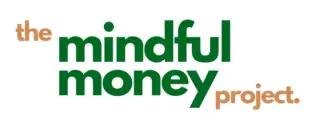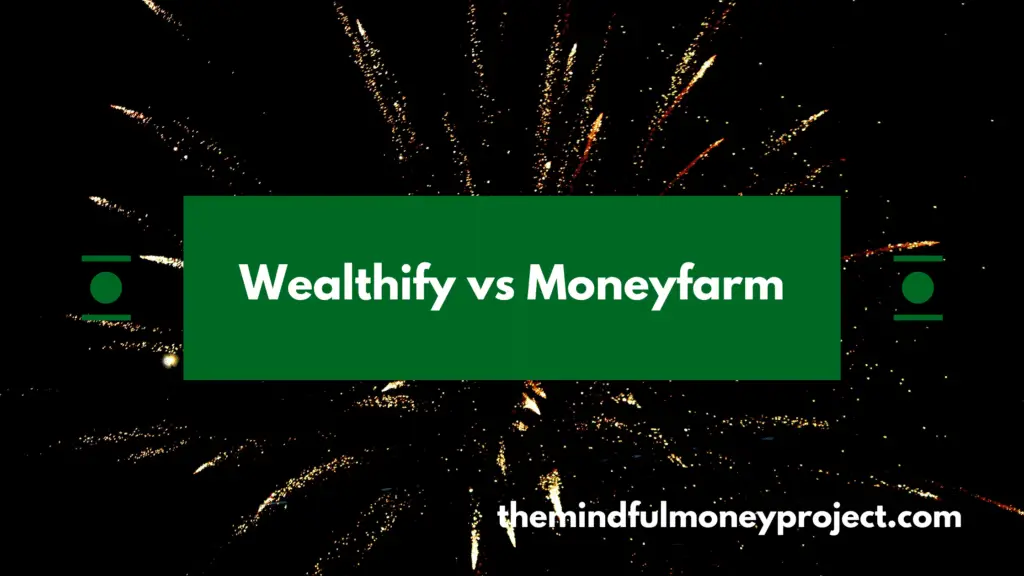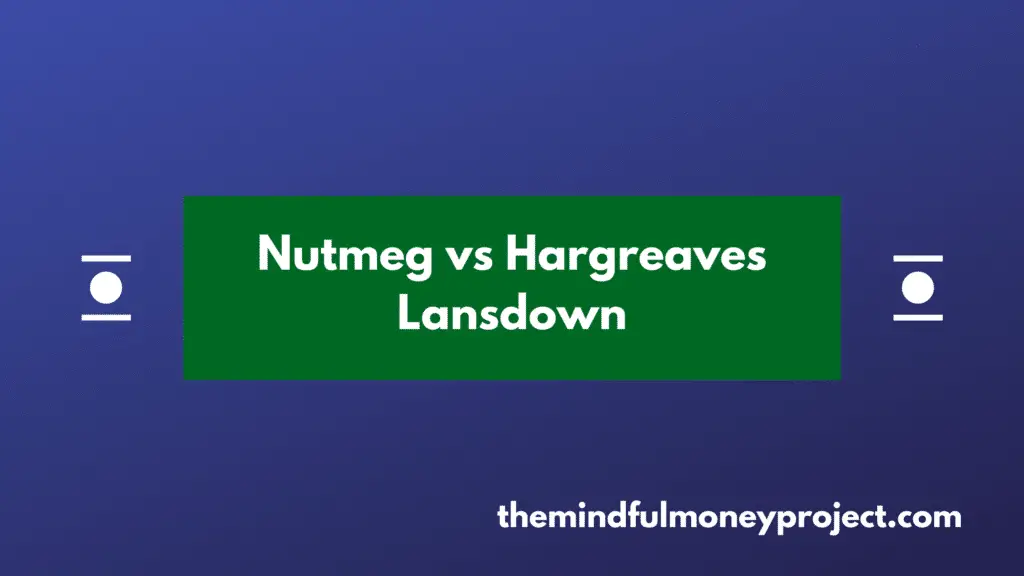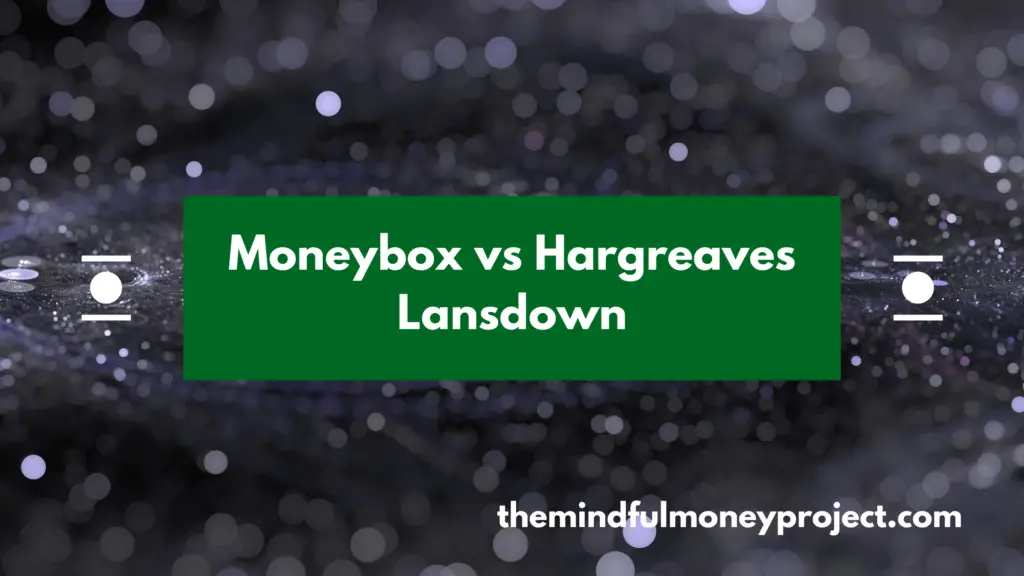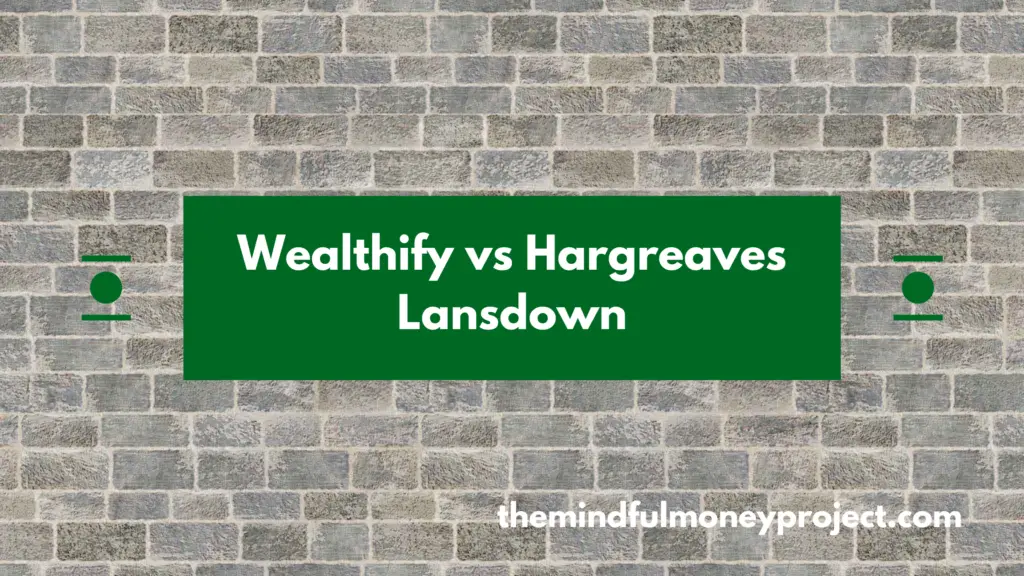If you’re looking to invest your money to reach your financial goals, you’ll be glad to hear there are lots of different investment apps and services you can choose from. All the way from picking your own portfolio, to having a robo advisor platform create a diversified portfolio for you.
The two services in our head to head will help with the latter. But which is the right choice?
Find out in our Wealthify vs Moneyfarm head to head.
Quick Summary
Busy investor just wanting the headlines? No worries, we got you:
Wealthify: best for low fees and low minimum investment for a ready-made portfolio
Moneyfarm*: best for investors who want the support of a digital wealth manager and a recommendation on which portfolio is most suitable
Wealthify
Pros
- Low minimum investment
- Lowest fees out of the two**
- Ethical investment options
Cons
- No questionnaire
Moneyfarm
Pros
- Questionnaire
- Dedicated investment expert
- Ethical investment options
Cons
- £500 minimum investment
**if investing less than £100k
Want to check out each round of the head to head in detail? Nice, keep on reading for the details!
The head to head: Moneyfarm vs Wealthify
Before we start, it is worth saying that nothing in this article should be seen as financial advice. With all investing, your capital is at risk. Even though we regularly update our content, please do your own research before investing. If you require financial advice, you can search for a regulated and qualified financial advisor via the Personal Finance Society.
How we assess the head to head:
In order to make an easy comparison between the two platforms, we’ve focused on the most important features:
- Range of investments available
- Ethical investing
- Range of accounts available
- Fees
- Existing customer reviews
- Minimum deposit requirements
- Withdrawal restrictions
- Platforms available
- FSCS protection
Round 1: Investments available
Wealthify uses low-cost funds to invest in the stock market (such as ETFs and mutual funds or index funds) from leading providers (such as Vanguard, Legal & General and Fidelity) to create your globally diversified portfolio. Their portfolios are managed by a team of qualified investment managers, so there is a level of active management. These managers will rebalance portfolios where needed based on Wealthify’s investment outlook.
You cannot construct your own portfolio with Wealthify. You select your portfolio based on your risk appetite, there is no investment advice or questionnaire to assess your own risk appetite, so you’ll need to have a feel for this yourself.
They have 5 portfolios to choose from, which Wealthify refer to as your “investment style”. The difference between them is essentially the asset allocation between stocks and bonds. The more “adventurous” funds contain a higher proportion allocated to stocks (>85%), which are generally more volatile in their returns than bonds. Whereas the more cautious bonds have a higher proportion allocated to bonds, which are generally less volatile.
- Cautious
- Tentative
- Confident
- Ambitious
- Adventurous
Wealthify is not regulated to give financial advice, so if you’re unsure what portfolio to pick or what investment is right for you, they won’t be able to suggest options! If this sounds like you, it might be worth seeking the advice of a financial adviser.
Moneyfarm offers a selection of 7 globally diversified portfolios made up of low-cost exchange traded funds (ETFs). These 7 portfolios are suited to different levels of risk tolerance, with the higher levels containing a higher stock allocation (>85%), with the lower levels containing a higher proportion of bonds (which are generally less volatile).
Where Moneyfarm differs significantly from Wealthify is that they are regulated to offer investment advice. At the beginning of your journey with Moneyfarm, they ask a range of questions aimed at understanding your financial goals, risk appetite and current experience of investing, all with the purpose of recommending the most suitable portfolio for you.
Not only that, but you will also get access to your own dedicated investment consultant who can help with any questions you may have.
The Moneyfarm portfolios are actively managed, which mean the investment team monitor your portfolio and rebalance where needed.
I haven’t pulled out the figures for past performance of investment growth, as past performance is not a reliable indicator of future performance. If you would like this, you can find it on both of their websites for their various portfolios.
Winner: Moneyfarm due to screening questionnaire recommending which portfolio
Round 2: Ethical investing
Wealthify offers ethical investing options, using actively managed funds that screen the companies they invest in. These exclude companies that operate in industries such as tobacco, weapons, gambling, nuclear power and companies engaging in unfair labour practices.
As they invest in actively managed funds from the likes of Kames Capital and EdenTree, if there are any changes in the companies in the fund (for example they start to engage in unethical business behaviour or diversify into one of the excluded industries, then the managers of the fund will spot this in their ongoing screening).
It is worth calling out though that the underlying funds may have differing levels of tolerance to excluded behaviours, with some allowing up to 10%. Wealthify has stated in their ethical guide that they always aim for as close to 0% in the funds they select. But bear this in mind when investing. If you’re wanting absolute control over your investments to ensure it is only being invested in ethical companies that are aligned to your values, you may be better served to build your own portfolio using a DIY platform.
With Moneyfarm, they offer a socially responsible version of each of their “standard” portfolios. These are constructed using data from MSCI (a leading global research house focusing on environment, social and governance practices, otherwise labelled as “ESG”).
The funds that are used in these socially responsible portfolios are selected (and then monitored) based on things such as:
- companies’ voting policies (i.e its governance structure)
- involvement in social controversies
- future exposure to ESG-related risks
As well as using the data from MSCI, Moneyfarm has its own set of screening. For example, eliminating all companies which do not operate, at a minimum, in ways that meet their fundamental responsibilities in areas such as labour, human rights, anti-corruption and the environment (as laid out in the United Nations Global Compact).
These are actively managed portfolios and so they are monitored on an ongoing basis to ensure compliance with their ESG parameters.
However, there is not as much transparency as I would personally like here from Moneyfarm. I understand there is complexity in understanding the underlying funds and stocks being invested in, but if you were looking to be very sure that the underlying investments were aligned with your values, you would have a tough job finding this out with Moneyfarm. Instead, you would have to trust that the processes and due diligence from Moneyfarm is sufficient. That being said, if you were looking for complete control over your investments so you know exactly what you are investing in, you may be better off building your own portfolio using a DIY platform like Hargreaves Lansdown. If you are happy to accept the convenience of a pre-made portfolio, you will have to accept a level of loss of control.
Winner: Draw
Round 3: Accounts available
On Wealthify, they have a range of accounts you can open:
- General Investment Account (GIA)
- Stocks and Shares ISA
- Junior ISA
- Personal Pension
With Moneyfarm, the accounts available are:
- General Investment Account
- Stocks and Shares ISA
- Personal Pension
Winner: Draw. Even though Wealthify offers a Junior ISA, the main accounts are covered on both.
Round 4: Fees
Wealthify has a simple fee structure. They simply charge a 0.60% annual platform fee on the invested amount, with an additional fund fee that is charged by the underlying funds within the Wealthify portfolio. This is 0.16% for the “original” plans and 0.7% for the ethical plans, bringing the total to either 0.76% for the “original” styles or 1.3% for the ethical portfolio.
This means that if you had £10,000 invested in one of their standard “original” styles, you will be charged an annual fee of 0.60% for the platform fee + 0.16% for the underlying funds. For a total of 0.76%.
Moneyfarm has a tiered pricing structure, made up of two components. 1 is the management fee on the investment amount, and then there is a fee relating to the underlying funds/investments. The management fee reduces the higher the investment, but the fee on the underlying investments remains flat at 0.29%.
- From £500 – £10,000: 0.75%
- £10,001 – £50,000: 0.6%
- £50,001 – £100,000: 0.5%
- £100,001+: 0.35%
This means that if you had invested £10,000, you would be charged an annual fee of 0.75% for the platform fee and up to 0.29% for the underlying fund charges, for a total of 1.04%.
Due to the tiered pricing, Moneyfarm becomes cheaper than Wealthify once you have £100,001+ invested, as the total fee becomes 0.64% (0.35% management fee + 0.29% fund charge). At the £50,001-£100,000 band, the differences become tiny, with Moneyfarm at 0.79% (0.50% management fee + 0.29% fund charge) vs Wealthify at 0.76% (0.60% platform fee + 0.16% fund charge).
Even though Wealthify is cheaper at the lower levels, it is worth bearing in mind that Moneyfarm offers a bit more guidance due to their opening questionnaires to figure out your investment goals, experience and risk appetite, as well as the investment expert on-hand for any questionnaires.
Winner: Wealthify due to lower fees
Round 5: Existing customer reviews
Wealthify have an average 4.6/5 on Trustpilot from 1.3k reviews at the time of writing. Positive reviews mention things such as the ease of the app/service and the available information helping you to make informed decisions. The poorer reviews mention delays in transferring/switching as well as a common theme around customer service either being too slow and/or not very helpful. Being the cheaper option out of the two, this is unsurprising.
Moneyfarm have an average 4.7/5 on Trustpilot from 655 reviews at the time of writing. Positive reviews discuss things such as the professional design of the platform, and that it feels like you have your own financial advisor (due to the questionnaires and on-hand investment expert). The poorer reviews mainly revolve around investment performance, but there are also some complaints around slow handling of withdrawals and transfers, which is something to bear in mind.
Winner: Draw. Both have very similar reviews with similar themes.
Round 6: Minimum deposit requirements
Wealthify allows you to invest with a minimum initial investment of only £1 on their ISA, GIA or Junior ISA accounts. The pension accounts have a minimum of £50.
Moneyfarm requires a minimum investment of £500.
Winner: Wealthify
Round 7: Withdrawal restrictions
There are no restrictions on the ISA and GIA accounts within Wealthify, and no charges or penalties. These just take up to 10 working days to release the funds as Wealthify need to sell the underlying investments. The Junior ISA and Pension accounts are restricted until maturity (in line with all other providers). So for a Junior ISA this is until the date of the child’s 18th birthday, and for Pensions, this is the date you turn 55.
For Moneyfarm, there are no restrictions on the accounts (other than the standard Pension restrictions where you cannot withdraw until you are 55). Withdrawals take up to 7 working days, and there are no fees or penalties.
Winner: Draw
Round 8: Platforms available
Wealthify has a web app you can log into via the browser, as well as an iOS and Android app.
Moneyfarm also has a web app (so you can access via your browser), as well as an iOS and Android app.
Winner: Draw
Round 9: FSCS Protection
Wealthify is protected by FSCS protection (up to the first £85,000) on ISA, General Investment and Pension accounts.
Moneyfarm is also covered by FSCS protection up to the first £85,000 are covered by the UK deposit guarantee scheme.
Winner: Draw
Conclusion: Wealthify vs Moneyfarm
Wealthify and Moneyfarm* both offer ready-made, globally diversified portfolios with transparent pricing and have some level of ethical investments available via their investment platform.
The Moneyfarm investment platform offers much more support, acting almost as a digital wealth manager, with a questionnaire to assess your goals, current experience and appetite to risk, as well as access to your own investment expert.
However, you do end up paying for this, as Moneyfarm has higher fees than Wealthify unless you’re investing more than £100,001.
Higher fees will mean lower returns as they eat into these returns. However, if you are a beginner or are not too comfortable with the idea of investing, then the additional support offered by Moneyfarm should give you the confidence to get started in investing.
If you are already more comfortable with the idea of investing, know your attitude to risk and want to get lower fees, then Wealthify is a better place to start. Especially if you’re starting with lower amounts to invest due to the low minimum investment needed.
However, if you are more comfortable with investing and therefore would look to put together your own portfolio of funds, you will be able to find much cheaper platforms in our alternatives roundup below (they may not come with the benefit of ready-made portfolios and investment advice, though):
Alternatives to Wealthify and Moneyfarm
Looking for alternatives to Wealthify and Moneyfarm? Well, you’re in luck. It’s a very competitive space. Where Moneyfarm and Wealthify are robo advisors offering a pre-made/ready-made investment portfolio, for more experienced investors willing to build their own investment portfolio, then some alternatives will offer far cheaper fees.
Are you new to investing? Check out our round-up of the best investing apps for beginners here.
For other investors, try:
- Nutmeg (robo adviser similar to Wealthify and Moneyfarm)
- Moneybox
- Freetrade* (more for trading individual stocks/shares)
- Stake* (specialises in US stocks)
- Vanguard (for market-leading low fees investing direct into a range of Vanguard fund(s))
- Hargreaves Lansdown (for a wide range of available investments)
Have you used both Wealthify and Moneyfarm? I’d love to hear your opinion on who wins in the head to head; Wealthify vs Moneyfarm in the comments below.
*Any links with an asterisk may be affiliate links. Even though we may receive a payment if you use this link to sign up for the service, it does not influence our editorial content and we remain independent. The views expressed are based on our own experience and analysis of the service.
Nutmeg vs Hargreaves Lansdown
With so many investment platforms and robo advisors to choose from, it is no wonder…
Moneybox vs Hargreaves Lansdown
Looking to grow your money with investing in the stock market but still nailing down…
Wealthify vs Hargreaves Lansdown
Investing in the stock market used to be an inaccessible world full of jargon, stockbrokers…
